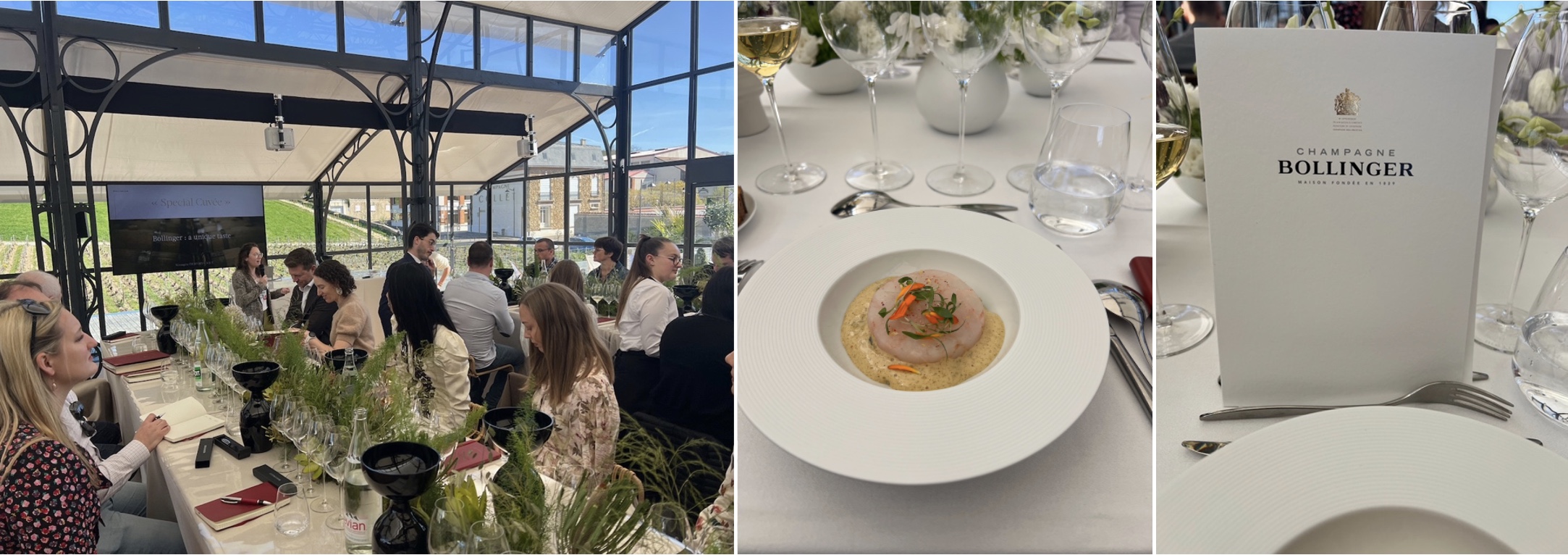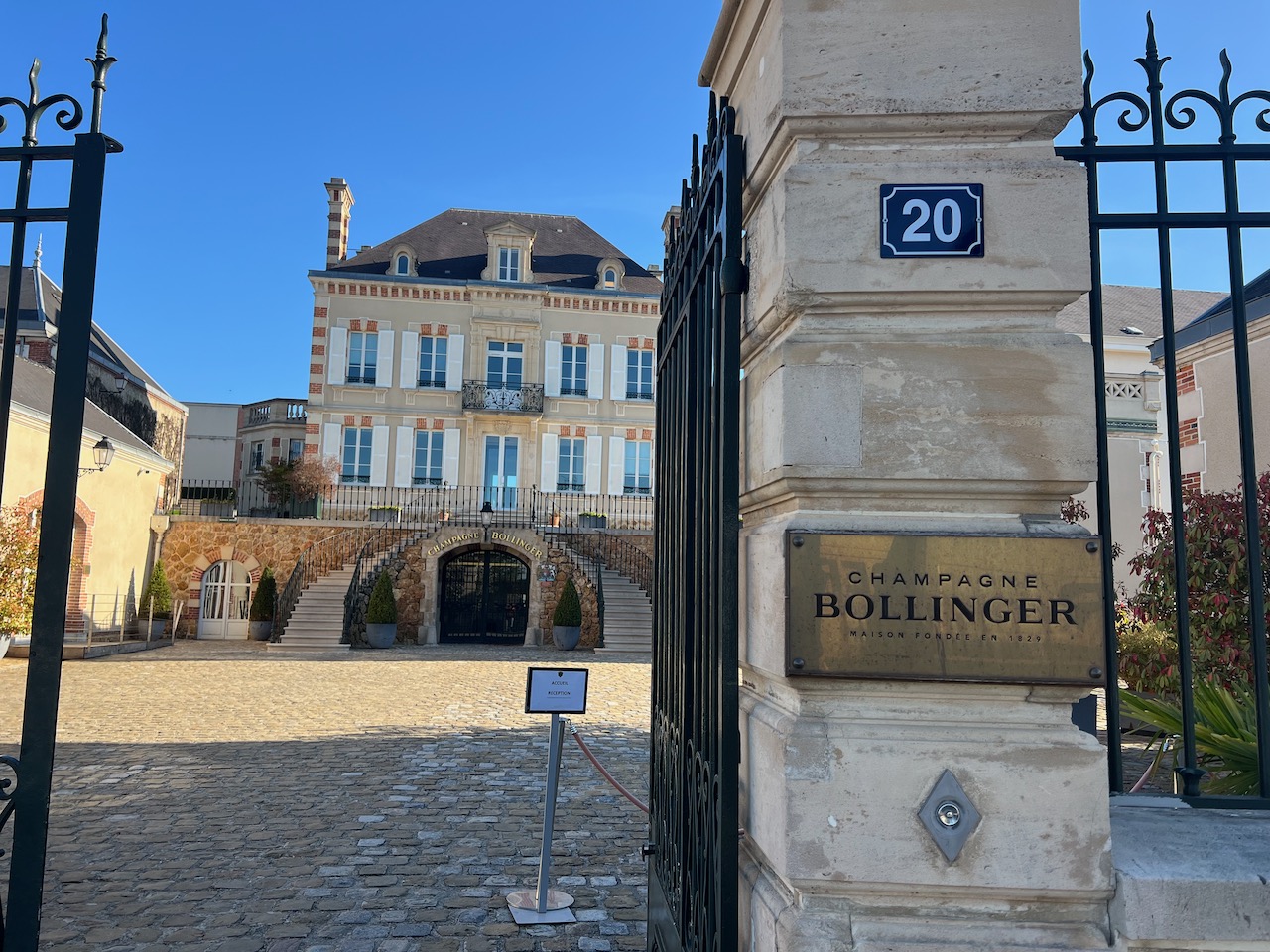I was very excited when I saw an invite in the Bollinger 1829 community program to taste some of the 2024 vins clairs. I have never done this in a structured, comparative way, only been offered samples here and there during visits with boutique grower-producers. This is really an opportunity that you can’t easily replicate as a normal consumer or even wine merchant. So, off I went to Ay for an exciting day. Before we dive into the day itself, a brief recap on Champage Bollinger itself.
Estate history and house style
Founded in 1829 in the village of Aÿ in the Montagne de Reims, Champagne Bollinger is one of the most iconic and historically significant houses in Champagne. The house was established by Hennequin de Villermont, Paul Renaudin, and Jacques Bollinger, whose name it eventually adopted. The most impactful member of the Bollinger family lineage through the years was Madam Lily Bollinger who ran the business from 1941-1971, established the brand globally and made many important innovations, including the creation of the R.D. cuvée. Bollinger has remained family-owned for most of its existence and became a benchmark for Pinot Noir-driven Champagnes, known for their structure and longevity. The house also gained considerable international recognition in the 20th century, particularly through its long-standing association with the British royal family and its prominent role in the James Bond films.
Bollinger farms over 170 hectares, more than 85% of which are classified as Grand or Premier Cru vineyards, primarily located in the Montagne de Reims and Aÿ. This unusually high proportion of estate-owned vineyards allows the house greater control over quality and style. Production is estimated at around two million bottles per year, which places Bollinger among the medium-sized Grandes Marques. The house is also notable for its traditional winemaking practices, including fermentation in old oak barrels, long lees aging, and a commitment to reserve wines stored in magnums under cork—methods that are rare even among the best grower-producers.
The Bollinger style is unmistakably Pinot Noir-led, with richness, depth, and vinous character at the core. Most cuvées feature a high percentage of Pinot Noir, often from Aÿ and Verzenay, lending them a firm structure and aging potential. The use of aged oak barrels for vinification adds oxidative complexity and texture. This approach is most evident in wines like La Grande Année and R.D. (Recently Disgorged), which are both aged extensively on the lees. Bollinger’s commitment to oxidative style, full malolactic fermentation, and time-intensive practices result in wines that are muscular yet refined, and always gastronomic.
Among Bollinger’s most renowned cuvées are the Special Cuvée (their non-vintage base cuvée of high quality), La Grande Année (their vintage cuvée), and R.D., which is the Grande Annéee disgorged much later to emphasize secondary and tertiary complexity. A special note deserves their prestige cuvée Vieilles Vignes Françaises, made from ungrafted Pinot Noir vines in tiny plots in Aÿ, is one of the rarest and most sought-after Champagnes in the world. Critics like Peter Liem describe Bollinger’s wines as “powerful and vinous, with a deeply traditional style,” while William Kelley notes that the house “continues to impress with a combination of technical precision and artisanal methods,” singling out La Grande Année as “one of Champagne’s most consistent high-achievers.”
Vieilles Francaises and elaborate process for the NV Special Cuvée
We did a quick walk around the estate and the cellar where I learned a few new interesting things. The first was regarding the famous “Pied Franc” Cuvée Vieille Vignes Francaises. It was originally three vineyards, but one recently succumbed to Phyloxera, so there are only two left, 2000 bottles in total. The one vineyard we visited is just behind the historic Bollinger house on a walled, south facing slope called Chaudes Terres. The wines are grown “en foule / layering” which is of course very rare today but was the norm in the 19th century. It surely looks interesting (see below) when you are accustomed to rows of well trained wines. More like a rose garden than a vineyard and itt takes about four times the work in the vineyard like that and the planting density is also much higher, 24’000 vines per hectare.

Bollinger’s Vieilles Vignes Francaises plots are trained “en foule”
We then took a tour through the cellar and vast crayeres where ca. 15 million Bollinger bottles are stored for ageing. We bumped into the two Remueurs at work, Olivier and Florent who have been with the company for a very long time. Florent some 30+ years and he mentioned that he will be retiring next year. Each of these guys can turn up to 45’000 bottles a day, crazy number if you think of it. We then stopped by at a stash of Magnums on cork that were vins de reserve for the NV cuvée. I was a bit confused because vins de reserve are usually stored in steel tanks. This is also the case at Bollinger but in addition 5-6 percentage points of the reserve wines are stored in Magnum and to keep longer undergo a mini fermentation with low pressure, like a vin petillante, and lay there for many years on lees. These reserve wines are then added to the NV cuvée with the reserve wines from steel tanks and are casually called “aromatic bombs”. We tasted one such magnum during the vin clair tasting and the name is really fitting. So much work, opening these magnums again, adding to the second fermentation or rather third fermentation for these wines. In the latest release of the NV cuvée we were told that the amount of reserve wines is a staggering 50% (in 2024 even higher). That is really high since the normal standard is more like 20-30%.
Vins Clairs Master Class
After the cellar tour we looked at a mock up of the big renovation works that are under way and the build up of an oenotourism center with ha boutique hotel with 20 rooms. This will complete in 2028 and I am looking forward to stay there once it is finished. We transferred atrium near by where a winemaker led us through the tastings of some vins clairs ranging from vintages 2012-2024. For confidentiality reasons of these unreleased wines, I will go go into detailed tasting notes but it was striking how different these individual components are. Chardonnay made in steel tank tastes like a racy Chablis, whites made from Pinot are more spicy but also astonishingly crisp. Once you add oak, the who game changes again with smoky and reductive notes coming into play. The older the wines get, the more patina they have and the more they taste like an aged white Burg. Very interesting was one of these aromatic bombs from the vintage 2012. I really felt I was drinking properly good, zero dosage Champagne with a bit less bubbles. Finally we tasted a combination of a vin clair assemblage that became the final blend and one could see that there sum was greater than the parts. The Bollinger team told us that they technically have 495 different vins clairs (300 tanks – 4000 barrels – 60 villages) of which they selected 131 for the NV 2024 blend and then made three different final versions (called project) of when then one got selected. A lot of work and a lot of know how. For those interested in statistics, the 2024 rendition will be 61/25/14 PN/CH/MN, 8% barrel wine, 65% reserve wines including 5% Magnum de Reserve, 3 years aging on lees, 6g dosage.

A selection of Bollinger Vins Clairs from Cuis and Verzenay
Over lunch we tasted some of the recent releases of the house and the group of attendees shared stories of their own wine and Champagne journey, cellar defenders and favorites, bucket list wines. It was a splendid day and well worth the travel.
Tasting notes of wines served over lunch wines
NV Bollinger Champagne Special Cuvée Brut, 93 Points
Always a contender for the best base line NV cuvée of any house. Aromatic nose with citrus and ripe apples, oak spices and some brioche. The lush palate is paired with a fresh finish.
2015 Bollinger Champagne La Grande Année, 94 Points
60/40 PN/CH. Chardonnay is from Chouilly and Avize. Discrete nose with biscuit on the top note as well as lemon and cut apples. Very good palate density without feeling heavy. Lovely now but I would give it a bit more cellar time. 94-95
NV Bollinger Champagne PN VZ19 Pinot Noir, 96 Points
This was my favorite wine in the line up. Wonderful richness with red fruit, spices, croissant. The is a youthful exuberance to this Champagne combined with palate density and structure coming from high quality Pinot fruit and oak aging.
2007 Bollinger Champagne R.D. Extra Brut , 95 Points
Very earthy and savory, yeasty with a lovely top note of sherry as well. 3g dosage, properly Extra Brut. It did well with air bringing more fruity elements to bear. Make sure to open this early or even give it a decant.

Author: Christian Raubach, WSET III, FWS, WSG Champagne Master
April 2025

